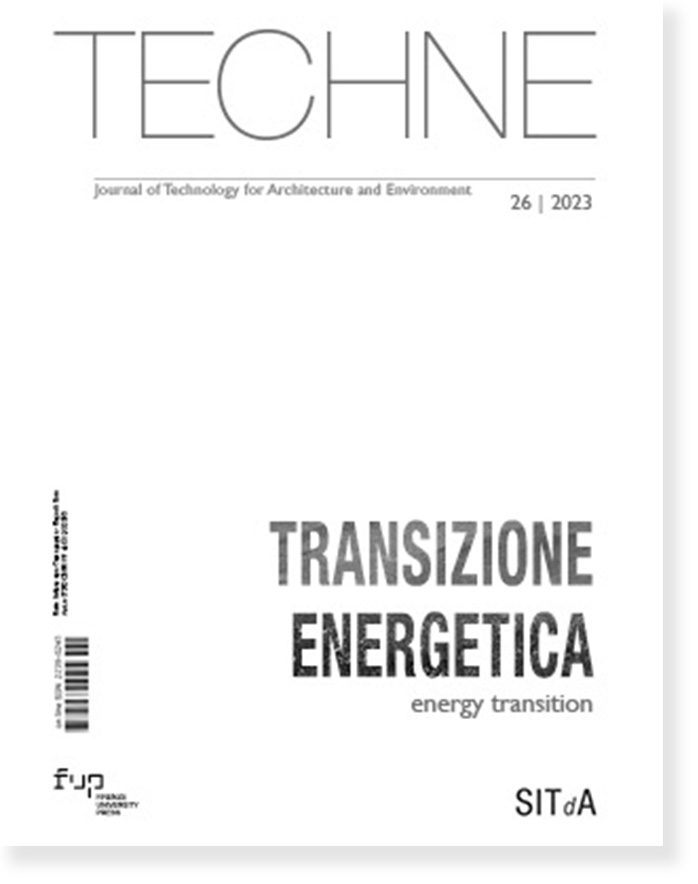Published 2023-10-31
Keywords
- Energy Transition,
- Renewable Energy Communities,
- Cultural Heritage,
- UNESCO Sites,
- Renewable Sources
How to Cite
Copyright (c) 2023 Giovanna Franco, Marta Casanova

This work is licensed under a Creative Commons Attribution 4.0 International License.
Abstract
The proposed decree of the Ministry for the Environment and Energy Security (MASE) encourages spreading self-consumption forms of energy from renewable sources, including Renewable Energy Communities (RECs). The paper proposes a mapping of the CERs already active in Italy, considerations on the main barriers that, at a national and international level, have hindered their diffusion, dwelling on the problems of compatibility in safeguarded and protected areas. Recalling projects and guidelines for installing photovoltaics in sensitive contexts, a first approach for a new CER in a UNESCO site is proposed as an opportunity to directly involve the Ministry of Culture as an actor in the energy transition processes.
Downloads
References
Brummer, V. (2018), “Community energy – benefits and barriers: A comparative literature review of Community Energy in the UK, Germany and the USA, the benefits it provides for society and the barriers it faces”, Renewable and Sustainable Energy Reviews, Volume 94, pp. 187-196.
Brunetta, G., Mutani, G., Santantonio, S. (2021), “Pianificare per la resilienza dei territori. L’esperienza delle comunità energetiche”, Archivio di Studi Urbani e Regionali, Vol. 131, pp. 44-70.
Coenen, F.H.J.M., Hoppe, T. (Ed.) (2021), Renewable Energy Communities and the Low Carbon Energy Transition in Europe, Palgrave Macmillan, Cham.
Colombo, G., Ferrero, F., Pirani, G., Vesco, A. (2014), “Planning Local Energy Communities to Develop Low Carbon Urban and Suburban Areas”, Proceedings of the IEEE International Energy Conference (ENERGYCON), Dubrovnik, Croatia, 13–16 May 2014, pp. 1012-1018.
De Lotto, R., Micciché, C., Venco, E.M., Bonaiti, A., De Napoli, R. (2022), “Energy Communities: Technical, Legislative, Organizational, and Planning Features”, Energies, Vol. 15. Available at: https://doi.org/10.3390/en15051731 (Accessed on 27/02/2023).
De Medici, S. (2021), “Italian Architectural Heritage and Photovoltaic Systems. Matching Style with Sustainability”, Sustainability, Vol. 13. Available at: https://doi.org/10.3390/ su13042108 (Accessed on 27/02/2023).
De Vidovich, L., Tricarico, L., Zulianello, M. (2021), Community Energy Map. Una ricognizione delle prime esperienza di comunità energetiche rinnovabili, Franco Angeli, Milano. Available at: https://series.francoangeli.it/index.php/oa/catalog/view/740/578/4397 (Accessed on 27/02/2023).
Eroe, K., Polci, T. (2022), Comunità Rinnovabili 2022, Legambiente. Available at: https://www.comunirinnovabili.it/wp-content/uploads/2022/05/CR2022-2.pdf (Accessed on 27/02/2023).
European Commission (2023), “EU Energy Communities Repository”. Available at: https://energy-communities-repository.ec.europa.eu/energy-communities/energy-communities-map_en (Accessed on 27/02/2023).
Fondazione per lo Sviluppo Sostenibile (2022), “La corsa delle regioni verso la neutralità climatica. Il primo ranking delle regioni italiane sul clima 2022”. Available at: https://www.fondazionesvilupposostenibile.org/wp-content/uploads/dlm_uploads/La-corsa-delle-Regioni-verso-la-neutralita-climatica-2022-Italy-for-Climate_compressed-1.pdf (Accessed on 27/02/2023).
Foster, G., Kreinin, H., Stagl, S. (2020), “The future of circular environmental impact indicators for cultural heritage buildings in Europe”, Environmental Sciences Europe, Vol. 32: 141. Available at: https://doi.org/10.1186/s12302-020-00411-9 (Accessed on 27/02/2023).
Franco, G. (2018), “Solar powered and eco-efficiency in a UNESCO site. Criteria and recommendations for the National Park of cinque Terre, Italy”, Energy & Buildings, Vol. 174, pp. 168-178.
Gerundo, R., Marra, A. (2022), “A Decision Support Methodology to Foster Renewable Energy Communities in the Municipal Urban Plan”, Sustainability, Vol. 14, 16268. Available at: https://doi.org/10.3390/ su142316268 (Accessed on 27/02/2023).
Gross, M., Mautz, R. (2015), Renewable energies, Routledge, London.
Huang, Z., Yu, H., Peng, Z., Zhao, M. (2015), “Methods and tools for community energy planning: A review”, Renewable and Sustainable Energy Reviews, vol. 42(C), pp. 1335-1348.
Lucchi, E., Polo Lopez, C.S., Franco, G. (2020), “A conceptual framework on the integration of solar energy systems in heritage sites and buildings”, IOP Conf. Ser.: Material Science and Engineering, Vol. 949.
Manni, V., Valzano, L.S., (2022), “Comunità energetiche. Strumento per riqualificare l’edilizia della ricostruzione post-bellica”, Techne, Vol. 24, pp. 119-126.
Marrone, P., Montella, I. (2022), “An experimentation on the limits and potential of Renewable Energy Communities in the built city: Buildings and proximity open spaces for energy decentralization”, Renewable and Sustainable Energy Transition, Vol. 2.
Ministero della Cultura (2015), Linee di Indirizzo per il Miglioramento Dell’efficienza Energetica nel Patrimonio Culturale; MIBACT, Roma.
Ministero della Cultura (2023), “Vincoli in rete”. Available at: http://vincoliinrete.beniculturali.it/VincoliInRete/vir/utente/login (Accessed on 27/02/2023).
Moser, D., Maturi, L. (2022), “Nuovi orizzonti della transizione energetica: sfide e opportunità per l’edilizia”, Techne, Vol. 24, pp. 40-45. Available at: https://oaj.fupress.net/index.php/techne/article/view/13440/11313 (Accessed on 27/02/2023).
Tarhan, M.D. (2015), “Renewable Energy Cooperatives: a Review of Demonstrated Impacts and Limitations”, Journal of Entrepreneurial Organizational Diversity, Volume 4, Issue I, pp. 104-120.
Todeschi, V., Marocco, P., Mutani, G., Lanzini, A., Santarelli, M. (2021). “Towards energy self-consumption and self-sufficiency in urban energy communities”, International Journal of Heat and Technology, Vol. 39, No. 1, pp. 1-11. Available at: https://doi.org/10.18280/ijht.390101 (Accessed on 27/02/2023).
Tsoumanis, G., Formiga, J., Bilo, N., Tsarchopoulos, P., Ioannidis, D., Tzovaras, D. (2021), “The Smart Evolution of Historical Cities: Integrated Innovative Solutions Supporting the Energy Transition while Respecting Cultural Heritage”, Sustainability, Vol. 13, 9358. Available at: https://doi.org/10.3390/su13169358 (Accessed on 27/02/2023).
UNESCO (2021), “Rapporto dell'UNESCO sulla scienza. La corsa contro il tempo per uno sviluppo più intelligente”. Available at: https://creativecommons.org/licenses/by-sa/3,0/igo/ (Accessed on 27/02/2023).
Wierling, A., Schwanitz, V.J., Zeiss, J.P. et al. (2023), “A Europe-wide inventory of citizen-led energy action with data from 29 countries and over 10000 initiatives”, Scientific Data, Vol 10, Available at: https://doi.org/10.1038/s41597-022-01902-5 (Accessed on 27/02/2023).






